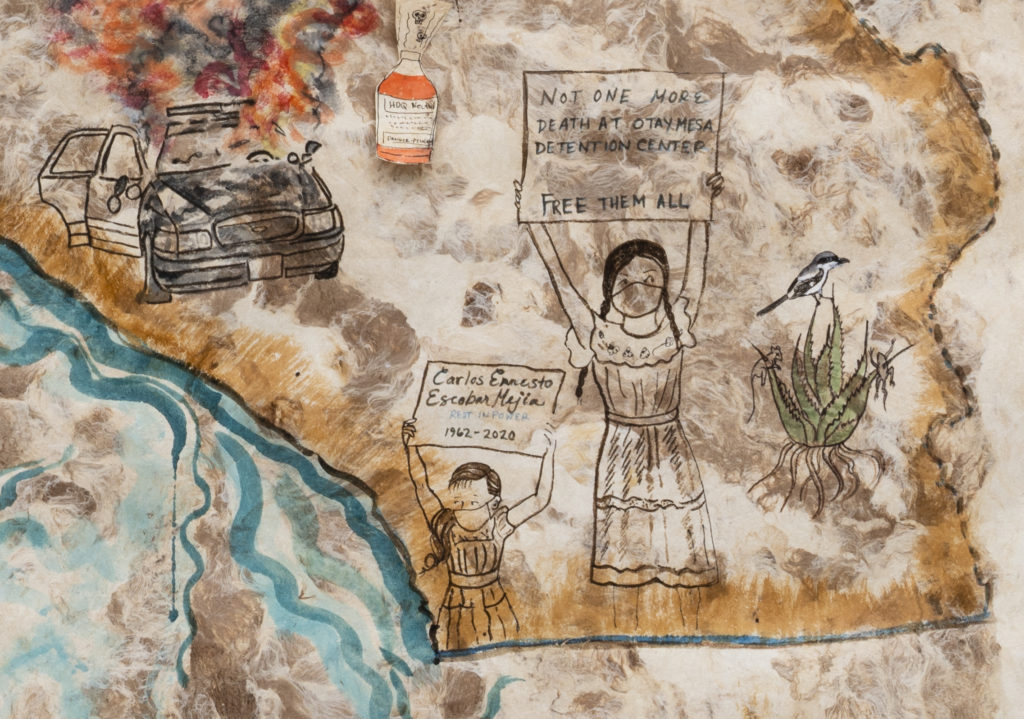Carter to Debut New Work by Sandy Rodriguez in Solo Exhibit
Illuminating the complexity of art-making amid a global pandemic, this December the Amon Carter Museum of American Art (the Carter) will present Sandy Rodriguez in Isolation, a selection of new works on paper conceived by the Los Angeles–based painter during her Joshua Tree Highlands Artist Residency in Southern California at the height of COVID-19. The exhibition features more than 30 landscapes, protest scenes, maps, and botanical studies, created using Rodriguez’s hand-processed inks and watercolors, which she derived from plants and mineral pigments native to the region. Reflecting on the ways artists have responded to past pandemics and uprisings, Rodriguez’s series connects the conflicts of the past year, including the public health crisis and flashpoints of racial injustice, to ancestral healing practices, both medicinal and creative. Sandy Rodriguez in Isolation will be on view at the Carter December 18, 2021, through April 17, 2022.

In spring of 2020, as the magnitude of the pandemic came into view, Rodriguez began her residency as the inaugural Alma Ruiz Fellow at Joshua Tree Highlands, situated at the junction of the Mojave and Colorado Deserts. The rapid news cycle of rising COVID fatalities and nationwide demonstrations against police brutality made Rodriguez feel deeply connected to a lineage of artists who have translated historic conflicts amid past pandemics through their work. In the slow, monastic setting adjacent to Joshua Tree National Park, she turned to the vocabulary of the surrounding desert as a guide for her response. Contextualizing her ongoing investigation into the methods and materials of painting across cultures, she collected botanical specimens linked to Nahua and Cahuilla healing practices for respiratory ailments, which she then processed as handmade paints with extracted plant colorants and mineral pigments. Within the first seven weeks of her stay, she produced over 60 objects capturing both the natural and sociopolitical environment she experienced through plant-life studies, portraits, landscapes, and maps that meditate on desert life amid a pandemic. Exhibiting the works completed through the course of her residency for the first time, alongside materials used in her paints and paper, Sandy Rodriguez in Isolation illustrates the painter’s creation of channels for healing past and present trauma through the recovery of Indigenous knowledge systems.

Images [left to right]: Sandy Rodriguez (b. 1975), Humwichawa / Arbol de Josue / Joshua Tree / Yucca brevifolia, 2020–21, hand-processed watercolor on amate paper, © 2020–21 Sandy Rodriguez; Sandy Rodriguez (b. 1975), Nocturne for Robert Fuller and Malcolm Harsch, 2020–21, hand-processed watercolor on amate paper, © 2020–21 Sandy Rodriguez; Sandy Rodriguez’s artist materials in the studio at Joshua Tree Highlands Artist Residency, 2021, photography © 2021 Elon Schoenholz
At the intersection of social memory, contemporary politics, and cultural production, Rodriguez’s work magnifies the ways in which knowledge—both personal and societal—is captured, shared, and preserved. Focusing on language and visual art as tools of documentation, she draws inspiration for her paintings from colonial-period writings and documents, namely the Florentine Codex. Authored by a Franciscan friar and Nahua scholars in the mid-16th century amid a pandemic, the encyclopedic work records the history and practices of the Indigenous cultures in Central Mexico, as well as the flora and fauna found in the region, with both Nahuatl and Spanish text and over 2,000 ink and watercolor illustrations.
Exactly 500 years from the time of conquest, the works featured in Sandy Rodriguez in Isolation activate this history by documenting the ecosystem of Rodriguez’s quarantine—with annotations in Cahuilla, Spanish, Latin, and English—and amplifying Indigenous insight on the medicinal and aesthetic significance of local plants and pigments. Further reclaiming precolonial art history, the exhibition highlights Rodriguez’s use of amate paper, a symbol of Indigenous culture that, having been used for codices and artworks, was destroyed and outlawed under Spanish rule. Rodriguez’s works are painted on amate paper made from bark and spices, by a fifth-generation Otomi papermaking family in Puebla, Mexico.

Sandy Rodriguez (b. 1975), Detail of Mapa de Califas—Atrocities, Isolation and Uprisings (in progess), 2020–21, hand-processed watercolor on amate paper, © 2020–21 Sandy Rodriguez
“Rodriguez’s work is a stunning synthesis of Chicana identity, ancestral iconography and techniques, and contemporary subjects,” said Maggie Adler, Curator of Paintings, Sculpture, and Works on Paper at the Carter. “She creates simply extraordinary works on paper, from the sophistication of the paper itself to her innovative use of handmade, historical pigments, and continues to ascend as a leader in the contemporary arts dialogue. Through this exhibition’s timely address of the year’s monumental events— as well as the museum’s recent acquisition of her large-scale watercolor map tracing sites along the U.S.-Mexico border where migrant children died in U.S. custody—Rodriguez deeply enriches the Carter’s engagement with some of the most pressing issues both within and beyond the arts.”
Sandy Rodriguez in Isolation is organized by the Amon Carter Museum of American Art and curated by Adler. Exemplifying the Carter’s mission to tell new and important stories of American art, Sandy Rodriguez in Isolation is part of a yearlong exhibition program celebrating the museum’s 60th year of collecting, preserving, and exhibiting the finest examples of American creativity.


 Sign in
Sign in

